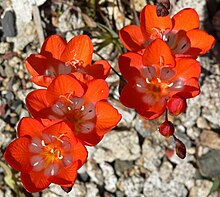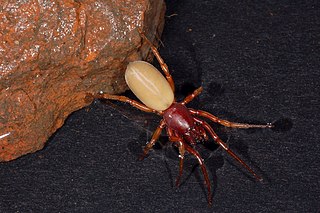
Dysderidae, also known as woodlouse hunters, sowbug-eating spiders, and cell spiders, is a family of araneomorph spiders first described by Carl Ludwig Koch in 1837. They are found primarily in Eurasia, extending into North Africa with very few species occurring in South America. Dysdera crocata is introduced into many regions of the world.

Iridaceae is a family of plants in order Asparagales, taking its name from the irises, meaning rainbow, referring to its many colours. There are 66 accepted genera with a total of c. 2244 species worldwide. It includes a number of other well known cultivated plants, such as freesias, gladioli and crocuses.

Oenanthe, known as water dropworts, oenanthes, water parsleys, and water celeries, are a genus of plants in the family Apiaceae. Most of the species grow in damp ground, such as in marshes or in water.

Cicutoxin is a naturally-occurring poisonous chemical compound produced by several plants from the family Apiaceae including water hemlock (Cicuta species) and water dropwort (Oenanthe crocata). The compound contains polyene, polyyne, and alcohol functional groups and is a structural isomer of oenanthotoxin, also found in water dropwort. Both of these belong to the C17-polyacetylenes chemical class.

The woodlouse spider is a species of spider that preys primarily upon woodlice. Other common names refer to variations on the common name of its prey, including woodlouse hunter, sowbug hunter, sowbug killer, pillbug hunter and slater spider.
Risus sardonicus or rictus grin is a highly characteristic, abnormal, sustained spasm of the facial muscles that appears to produce grinning. Risus sardonicus may be caused by tetanus, strychnine poisoning, or Wilson's disease, and has been reported after judicial hanging.

Joseph Salim Peress, was a pioneering British diving engineer, inventor of one of the first truly usable atmospheric diving suits, the Tritonia, and was involved in the construction of the JIM suit.

Ridolfia segetum, called false fennel, corn parsley, or false caraway, is an annual weed of the Mediterranean region. Its height 40–100 cm. The stem is erect, striate, and branched. The glabrous leaves are finely divided several times with filiform leaflets, the upper leaves frequently reduced, and the base of the petiole enlarged. The flowers are yellow, arranged in small umbels with almost uniform rays (10-60).
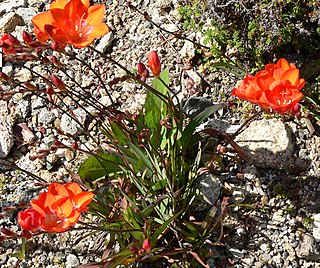
Tritonia is a genus of flowering plants in the iris family first described as a genus in 1802. They are naturally distributed across southern Africa, with a high concentration of species in Cape Province of western South Africa. The genus is closely related to the genus Ixia.

Oenanthotoxin is a toxin extracted from hemlock water dropwort and other plants of the genus Oenanthe. It is a central nervous system poison, and acts as a noncompetitive antagonist of the neurotransmitter gamma-aminobutyric acid. A case has been made for the presence of this toxin in local Oenanthe species playing a causative role in euthanasia in ancient Sardinia. It was crystallized in 1949 by Clarke and co-workers. It is structurally closely related to the toxins cicutoxin and carotatoxin. Oenanthotoxin is a C17 polyacetylene isomer of cicutoxin.
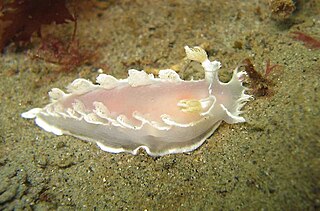
The Tritoniidae are a taxonomic family of dendronotid nudibranchs, shell-less marine gastropod molluscs. This family includes some of the largest known nudibranchs, with the NE Atlantic species Tritonia hombergii reaching 20 cm in length.

Crocoideae is one of the major subfamilies in the family Iridaceae.

Tritonia is a genus of sea slugs, nudibranchs, shell-less marine gastropod molluscs in the family Tritoniidae.

Agonopterix yeatiana is a moth of the family Depressariidae. It is found in most of Europe.
Dropwort is a common name for several plants and may refer to:
Blazing star may refer to:
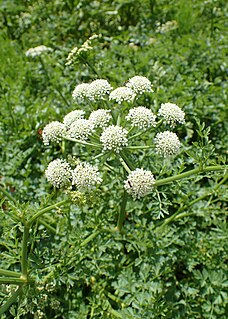
Oenanthe crocata, the hemlock water-dropwort, is a flowering plant in the carrot family, Apiaceae. Scientists at the University of Eastern Piedmont in Italy wrote that they had identified Oenanthe crocata as the plant responsible for producing the sardonic grin. This plant is a possible candidate for the "sardonic herb", which was a neurotoxic plant referred to in ancient histories. It was purportedly used for the ritual killing of elderly people and criminals in Nuragic Sardinia. The subjects were intoxicated with the herb and then dropped from a high rock or beaten to death.
